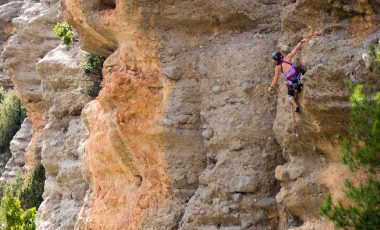As the second most mountainous country in Europe, it’s little wonder that the Spanish climbing scene has so much to offer. And despite its reputation of being home to some of the toughest routes in the world, climbing in Spain isn’t just reserved for experienced, top level climbers. There are many excellent climbing areas that cater for all types of rock climbers. Whether you’re a beginner climber wanting your first taste of real rock, an intermediate climber hoping to improve your grades and technique or an experience climber looking to push your limits, a trip to Spain will most certainly have your needs and wants covered.
Header photo credit: Brian Stone
- Catalonia: Abella de la Conca
- Mallorca
- Costa Verde: Roca Verde
- Costa Blanca
- Andalusia: El Chorro
- Madrid: La Pedriza
6 top class Spanish climbing areas
Our quick guide to the top Spanish climbing spots includes info on where to multi-pitch trad climb, some bouldering hotspots, sport climbing meccas and where to try out deep water soloing.
Catalonia: Abella de la Conca
| Type of climbing: | Sport and trad |
| Best for: | All levels |
| Rock type: | Limestone |
| Best time to go: | September to May |
There is no shortage of world class sport climbing in Catalonia. Within a couple of hours of Barcelona thousands of routes lure climbers in from all over the world. But for an area that is a little off the beaten track and away from crowds a visit to Abella de la Conco should be high up on your Catalonia itinerary. A short walk from the tiny village nestled into the rock face, you’ll find hundreds of high quality, well-bolted climbs that cater for all levels. Drive a little way from the village and the vast variety rock types and climbing styles will have you extending your stay immediately.
Of course the untouched beauty and tranquility of the area doesn’t help with that! And if you stay at the Abella Eco-refugi, their exceptional vegetarian food and hospitality won’t help either.
There are plenty of shady areas to be found during the summer months, but rock climbing in Catalonia, like much of Spanish climbing, is best done during the winter.
To best experience Abella de la Conca, sign up to a sport climbing course with Climb Catalunya. Read our full review of the course.

Mallorca
| Type of climbing: | Deep water soloing (DWS), sport climbing |
| Best for: | Intermediate to advanced climbers |
| Rock type: | Limestone |
| Best time to go: | June to December for DWS, September to May for sport climbing |
The island of Mallorca is one of the best deep water soloing locations in world and home to hundreds of top class routes that soar above the crystal waters of the Mediterranean Sea. Many of the best DWS crags can be found on the south east of the island, including Cala Serena — the largest of the DWS crags on the island. Cala Serena offers over 100 routes up to 18m high. Though there are a few lower grade climbs, most of the routes are suitable to more experienced climbers working at 6a and above. As well as only being a short walk to plenty of accommodation options and amenities, climbers can expect overhangs galore, curious caves and tufas aplenty.
For those not wanting to get their toes wet, Mallorca isn’t short of some superb sport climbing. Head to the west coast and hit up Sa Gubia and take on one of the 125+ routes graded from 4 – 8.
Experience DWS for the first time on a guided trip with Rock and Ride.
Costa Verde: Roca Verde
| Type of climbing: | Sport |
| Best for: | All levels of climbers |
| Rock type: | Limestone |
| Best time to go: | May to December |
One of the less well-known gem’s of the Spanish climbing scene can be found in Northern Spain’s Costa Verde. When the rest of the Spanish climbing crags see their quietest months due to sizzling temperatures, the cooler climate in the Asturias region makes it a superb option for a summer climbing vacation. Sport climbers of all levels can enjoy over 3500 well-bolted single and multi-pitch routes on majestic limestone cliffs that soar above the verdant countryside.
This up and coming sport climbing area is an ideal getaway for those wanting to get off the beaten track and properly experience rural Spain. Plus, it’s a good opportunity to practise your best Spanish — very few locals speak English.
Get there while you can, and before it becomes over-developed.
For more information about the area and the routes go to Roca Verde Climbing where you can also buy the climbing guide for the region.
Costa Blanca
| Type of climbing: | Sport and trad |
| Best: | All levels of climber |
| Rock type: | Limestone |
| Best time to go: | September to May |
With easy transport options to Alicante from the rest of Europe, the Costa Blanca is one of the most popular Spanish climbing destinations. It is also a top spot for winter climbing trips where climbers can enjoy moderate temperatures from September right through to May. As well as a welcome winter getaway, it’s the sheer variety of routes, grades and style of climbing that attracts climbers from all over the world to explore the area. With short and steep sport routes, multi-pitch mountain trad climbs and semi-bolted sea cliff adventures, you’ll not get bored of the area in a hurry. And with over 4000 recorded routes there are plenty of options to suit climbers of abilities.
With so much on offer, a guided climbing vacation can help minimise the faff and get the most out of your time in the area.
Andalusia: El Chorro
| Type of climbing: | Sport and some trad |
| Best for: | All levels |
| Rock type: | Limestone |
| Best time to go: | October to April |
Another not to be missed winter climbing destination is El Chorro located in the southern region of Andalusia. Like the Costa Blanca, the temperatures in this area soar during the summer months but stay pleasantly moderate through Europe’s colder seasons. Plus, the easy access to Malaga airport and cheap flights there make El Chorro a Spanish climbing hotspot.
Climbers of all levels can enjoy a variety of single and multi-pitch sport routes that can found deep in the stunning, and sometimes intimidating El Chorro Gorge. The area boasts over 800 routes that offer pumpy overhangs to delicate slabs and everything in between. Additionally, most of the crags are within walking distance of El Chorro village making it an excellent destination if you don’t have wheels (infrequent trains run from the Malaga area to El Chorro).
Madrid: La Pedriza
| Type of climbing: | Sport, bouldering and trad |
| Best for: | Intermediate to advanced climbers |
| Rock type: | Granite |
| Best time to go: | October to April |
If you like tough friction slab climbing then you’ll love La Pedriza. Located in Sierra de Guadarrama National Park, just an hour north of Madrid, the area offers a vast number of routes that will challenge your mental game as much as your footwork. Many of the sport routes are not as friendly, in terms of their bolted protection, as most of other climbing areas in Spain. But there are still well-protected routes to be found, not to mention the superb trad routes and enough world class bouldering problems to keep you busy for a very long time!
There are easy transport options from Madrid to this highly unique climbing area with most of the routes being walkable within a couple of hours. It is best avoided during the summer months due to heat, but the area makes for a excellent winter trip. La Pedriza climbing offers crimpers, cracks and slopers galore and is an unmissable spot to learn a thing or two.
There’s no doubt that the Spanish climbing scene really has a lot to offer. Whether you sign up to climbing trip, hire a guide or go explore the crags with your own crew, be sure to do it safely and sensibly. And of course, have fun!



